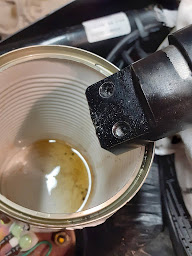The bike went through its annual MOT (Ministry of Transport) test for roadworthiness as a pass an with no advisories. Advisories being little jobs that need addressing to bring the bike up to MOT standard but not serious enough to constitute a danger to the safety of the vehicle. The testing bloke commented that the bike was a nice example of the marque and in really good order. That was nice to hear given the light restoration I had given it over the winter. He mentioned the action of the clutch lever in passing. I had noticed the bite of the clutch took a little getting used to. I remembered I had topping up the brake fuild in the reservior as a job to do. The fluid was just above the minimum marker. The screws in the reservoir cap were really tight so I put it to the bottom the list as the clutch was working just fine. Now I thought I would do that top up job.
I first got the screwdriver out again and tried the screws. Nothing moved. I did my usual trick of soaking the screws in 3in1 oil over a few days and tried the screws again. I only managed the round them off. I got the thread extarctor kit out. The kit is a series of what look tapered screws but with a left hand thread. The tool is screwed in the rounded hole which was the head of the set screw and turned. The thread bites and is supposed to release the screw....nope, the hole just got bigger. I got the electric drill out and found a drill bit a shade smaller than the head of the screw.
I very carefully drilled out the head of the screw to leave just the thread portion of the screw in position. I had to be very careful. The reservior cap and body the body of the master cylinder is made from a magnesium alloy which is much softer than the steel of the set screw. One slip could damage the cap or body. That would mean a new master cylinder, the sourcing of which would cost time and money. So far this job had cost £3.80. Patience paid off. As soon as the heads where drilled out the reservoir cap came away undamaged. The screw threads were still in the reservoir body. With some tepidation I turned the remainder of the screw with my fingers. The thread turned easily and were removed in seconds to my great relief. I was not happy contemplating stud extraction for the master cylinder body. The fluid in the reservoir look really dirty. I guess it has been in there since the bike was built in the factory. I used a syringe to remove most of it and topped up te reservoir with fresh clutch/brake fluid. The oil seals and space was cleaned and refitted. The reservoir cap was cleaned and checked that the new screws would seat in the cap. There was a lot of corrosion at the base of the set screw as it went into the master cylinder body. That was what was preventing the screw coming out. I put a smear of copper slip grease on the underside of the set screw before refitting it through the cap. The screw seated nicely. So that job was done. Whilst I was about ti replaced the screws in the front brake master cylinder. These screws came out with much effort. The new screws were copper greased and refitted. The work of a few minutes.
Whilst I was dealing with the clutch master I took off the clutch lever and actuating rod. These components were dirty but well oiled. I cleaned up the lever, rod and housing then a liberal dose of LM grease the rod was refitted into the clutch piston and the other end into the clutch lever. The lever was then positioned for the pivot bolt to be relocated and the securing nut fitted. The lever action feels a good deal smoother.
Three jobs ticked off the list and one added......change clutch fluid.












